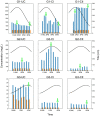Microbial Diversity in Groundwater and Its Response to Seawater Intrusion in Beihai City, Southern China
- PMID: 35910635
- PMCID: PMC9328385
- DOI: 10.3389/fmicb.2022.876665
Microbial Diversity in Groundwater and Its Response to Seawater Intrusion in Beihai City, Southern China
Abstract
Seawater intrusion is a major concern commonly found in coastal aquifers worldwide. Because of the intense aquifer exploitation and land-based marine aquaculture in the coastal area of Beihai City, Guangxi Zhuang Autonomous Region, China, numerous underground aquifers in this area have been affected by seawater intrusion. However, the microbial communities in freshwater aquifers and their response to seawater intrusion are still unclear. In this study, groundwater from three aquifers was collected from three monitoring sites at different distances from the coastline in the coastal area of Beihai City, and the hydrochemical characteristics of these groundwater samples and the structure of the associated microbial communities were analyzed. The Cl- concentration of the samples indicated that seawater intrusion had occurred in the research area up to 1.5 km away from the coastline, but the monitoring site 2 km away from the coastline had yet to be affected. Statistical analysis showed that the bacterial communities in different groundwater aquifers were significantly correlated with the Cl- concentration, thereby suggesting that the extent of seawater intrusion might be one of the primary factors shaping bacterial composition in groundwater of this area, but the composition and distribution of archaea did not show a significant response to seawater intrusion and presented no apparent correlation with the Cl- concentration. α-, γ-Proteobacteria and Bacteroidota were the dominant bacterial lineages, accounting for about 58-95% of the bacterial communities. Meanwhile, the predominant archaeal taxa were mainly composed of Crenarchaeota, Nanoarchaeota, and Thermoplasmatota, as accounting for 83-100%. Moreover, there was significant spatial heterogeneity of microbial communities in the aquifers affected by varying degrees of seawater intrusion. The microbial communities inhabiting the unconfined aquifer were influenced by the geochemical fluctuation caused by seawater infiltration from land-based marine aquaculture ponds and the diffusion of eutrophic surface water. In contrast, changes in microbial community structure in the confined aquifers were closely related to the environmental gradient caused by different degrees of seawater intrusion. In addition, we also found that the tidal cycle did not significantly affect the structure of microbial communities inhabiting confined aquifers that had been long affected by seawater intrusion.
Keywords: Beihai City; aquifers; groundwater; microbial diversity; seawater intrusion.
Copyright © 2022 Ma, Gao, Sun, Liao, Bai, Wu and Li.
Conflict of interest statement
The authors declare that the research was conducted in the absence of any commercial or financial relationships that could be construed as a potential conflict of interest.
Figures







Similar articles
-
Evaluation of spatial and temporal dynamics of seawater intrusion in coastal aquifers of southeast India: insights from hydrochemical facies analysis.Environ Monit Assess. 2024 Jan 20;196(2):179. doi: 10.1007/s10661-024-12306-w. Environ Monit Assess. 2024. PMID: 38244082
-
Seawater intrusion vulnerability in the coastal aquifers of southern India-an appraisal of the GALDIT model, parameters' sensitivity, and hydrochemical indicators.Environ Sci Pollut Res Int. 2019 Apr;26(10):9755-9784. doi: 10.1007/s11356-019-04401-0. Epub 2019 Feb 7. Environ Sci Pollut Res Int. 2019. PMID: 30729440
-
Microbial community dynamics across salinity gradients in coastal aquifers: Linking hydrogeochemical variability to prokaryotic diversity in a seawater-intruded aquifer of the Pearl River Delta, China.Mar Environ Res. 2025 Aug 20;211:107471. doi: 10.1016/j.marenvres.2025.107471. Online ahead of print. Mar Environ Res. 2025. PMID: 40848571
-
Morocco's coastal aquifers: Recent observations, evolution and perspectives towards sustainability.Environ Pollut. 2022 Jan 15;293:118498. doi: 10.1016/j.envpol.2021.118498. Epub 2021 Nov 16. Environ Pollut. 2022. PMID: 34798220 Review.
-
Geophysical investigation for seawater intrusion in the high-quality coastal aquifers of India: a review.Environ Sci Pollut Res Int. 2023 Jan;30(4):9127-9163. doi: 10.1007/s11356-022-24233-9. Epub 2022 Nov 30. Environ Sci Pollut Res Int. 2023. PMID: 36449240 Review.
Cited by
-
Deciphering the functional and structural complexity of the Solar Lake flat mat microbial benthic communities.mSystems. 2024 Jun 18;9(6):e0009524. doi: 10.1128/msystems.00095-24. Epub 2024 May 10. mSystems. 2024. PMID: 38727215 Free PMC article.
-
From the Mountain to the Valley: Drivers of Groundwater Prokaryotic Communities along an Alpine River Corridor.Microorganisms. 2023 Mar 17;11(3):779. doi: 10.3390/microorganisms11030779. Microorganisms. 2023. PMID: 36985351 Free PMC article.
References
-
- Abd-Elhamid H. F., Javadi A. A. (2011). A cost-effective method to control seawater intrusion in coastal aquifers. Water Resour. Manag. 25, 2755–2780. doi: 10.1007/s11269-011-9837-7 - DOI
-
- Alderkamp A., Sintes E., Herndl G. (2006). Abundance and activity of major groups of prokaryotic plankton in the coastal North Sea during spring and summer. Aquat. Microb. Ecol. 45, 237–246. doi: 10.3354/ame045237 - DOI
-
- Archana A., Francis C. A., Boehm A. B. (2021). The beach aquifer microbiome: research gaps and data needs. Front. Environ. Sci. 9:653568. doi: 10.3389/fenvs.2021.653568 - DOI
-
- Aromokeye D. A., Richter-Heitmann T., Oni O. E., Kulkarni A., Yin X. R., Kasten S., et al. (2018). Temperature controls crystalline Iron oxide utilization by microbial communities in Methanic ferruginous marine sediment incubations. Front. Microbiol. 9:2574. doi: 10.3389/fmicb.2018.02574, PMID: - DOI - PMC - PubMed
LinkOut - more resources
Full Text Sources

